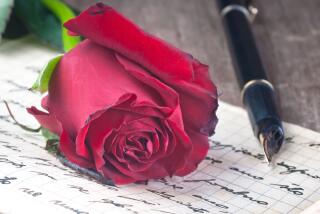BY DESIGN : Pen Pals
- Share via
In the 1949 film “A Letter to Three Wives,” a trio of attractive women learns that a friend has run off with one of their husbands. What is intriguing is not the outcome of the Joseph Mankiewicz tale (you’ll have to rent the video), but the propriety with which the diabolical missive is written.
Even a husband-stealer like Addie Ross wrote on monogrammed stationery using a fountain pen and some very impressive penmanship.
These days, more of us seem to be clamoring for exactly the same kind of polished correspondence--although not necessarily for such dastardly purposes. The U.S. Postal Service reports a marked increase in personal letters in recent years, and merchants have noticed a renewed interest in fine pens.
A good primer on the history and beauty of fountain pens is Jonathan Steinberg’s copiously illustrated new book, “Fountain Pens” (Courage Books). In it, he traces a couple of the people crucial to the development of the perfect writing instrument.
(The inventor of the early 20th Century piston-filling fountain pen, for example, performed regularly as a roller-skating transvestite in vaudeville.)
While “Fountain Pens” lingers over exquisite vintage pens, anyone researching ideas for a contemporary model would have better luck at their local pen counter. The best way to judge a fountain pen is to write with it.
Joan Flax says she once spent four hours helping a customer pick the right fountain pen at her family-owned artist supply store, Flax, where singer-songwriter Joni Mitchell, humorist Mort Sahl and actor Peter Falk buy their pens. “It’s a very personal thing,” she says.
The Westood store’s well-made fountain pens start at $30 and end at $10,000 for a solid gold Montblanc. Most aficionados choose something in between.
Plump, hand-painted Namiki pens from Japan have 18-karat gold nibs and are $350; Germany’s clean-lined Rotring--with its architect-designed clip--is $70.
Although pen buyers may overlook Sheaffers--associating them with the low-end drugstore models--the American-made pens deliver good value for the price, Flax says. Another American company, A.T. Cross, recently reissued a pen based on one of its 1930s designs, called the Townsend, that starts at $55.
Once you’ve settled on price range, make, model and color, the question of the nib remains. Medium is most popular. But some people prefer a more, uh, dynamic form of expression. “This one guy ordered a nib so big, it looked like a screwdriver,” Flax says with a laugh. “He was thrilled.”
Which brings us back to where we started. What are letter writers trying to tell the world?
That they have money and taste (a green Pelikan pen is the new Rolex in Hollywood).
That they take their sensual pleasures where they can get them (what could be safer than rolling smooth purple ink across a sheet of beautiful Italian paper?).
That they live in the moment, like to dance, avoid meaningful self-examination . . . oops, that’s what graphologist Arlyn J. Imberman said my handwriting reveals.
That there is more to life than faxing and E-mailing.
More to Read
The biggest entertainment stories
Get our big stories about Hollywood, film, television, music, arts, culture and more right in your inbox as soon as they publish.
You may occasionally receive promotional content from the Los Angeles Times.








